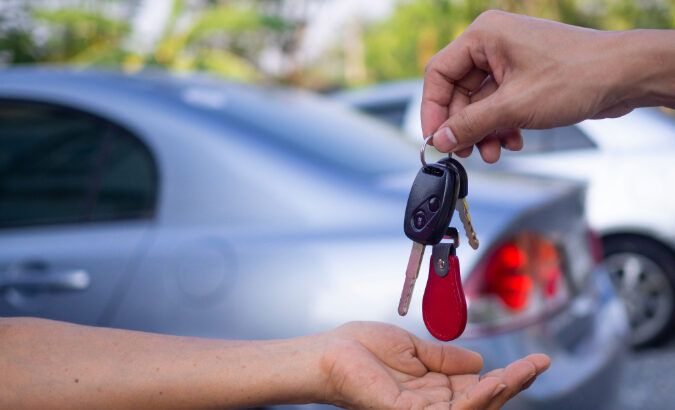
Riding a motorcycle can be a freeing and fun experience. But before you cruise off into the sunset, you need to learn to ride a motorcycle first. There’s a lot to keep in mind, so follow our 11 steps on how to ride a motorcycle to get a grasp on some of the fundamentals.
1. Put on motorcycle gear
When riding a motorcycle, there’s nothing separating you from your environment. This makes wearing the correct gear crucial for staying safe on the road. Here are the things you should equip[1]:
Helmet — Find a helmet designed for motorcycle riding that’s compliant with U.S. Department of Transportation regulations. Make sure it fits well and allows you to maintain your normal range of vision.
Eye and face protection — Goggles and a shatterproof face shield will protect your face from road debris and when you’re in a collision. When equipping your face protection, check that it fits securely and you can still see properly.
Clothing — Garments that cover most of your body, such as long pants and jackets, will provide the most protection. You’ll also want to supplement your clothing with gloves and over-ankle boots. Even with so much clothing, you should still be able to move without any restrictions.
2. Know all motorcycle controls and symbols
You won’t get very far on your motorcycle without knowing how to use each of its controls. While we have some of the basic motorcycle controls listed below, it’s a good idea to consult your owner’s manual for the specifics on operating your bike[2]:
Handlebars — Stationed at the front of the bike, the handlebars help you steer the bike.
Throttle — Located within the right handlebar, the throttle controls the speed of the bike. Speed up by rolling on the throttle (twisting it towards you); slow down by rolling off (twisting it away). When you let go, the throttle should spring back to its original position.
Front brake lever — The front brake lever is in front of the throttle on the right handlebar. Squeeze the lever to brake the front wheel.
Rear brake lever — The rear brake lever is by the right footrest. Press it down with your foot to apply the brake to the rear wheel.
Clutch — The clutch is on the left handlebar, opposite the front brake lever. You pull the clutch in order to change gears. The clutch is automatically engaged in its normal position. To disengage, just squeeze the clutch.
Shift lever — The shift lever is what actually changes the transmission’s gears. Located by the left footrest, you move the lever up and down with your foot to select the desired gear.
Ignition switch — The ignition switch turns the ignition system on or off. The ignition works in conjunction with the starter button to start the bike.
Starter — The starter button is what you use to start your bike after turning on the ignition. The starter is found on the right handlebar by the throttle.
3. Inspect the bike
Inspecting your motorcycle regularly will help it stay in good condition and keep you safe while riding. Try to check your bike weekly and before every ride. When you do, take a look at the following[1]:
Tires — Check the air pressure and look for any wear.
Fluids — Ensure you have the right oil and fluid levels.
Headlight and taillight — Verify that both lights are operational.
Turn signals — Test your turn signals and make sure both the front and rear signal lights work.
Battery — Review the condition of your battery and check that it’s firmly attached. (If it’s dead, you can try jump-starting it.)
Brake light — Apply each brake control individually to make sure they’re both able to turn on the brake light.
Chain or belt — Check your chain or belt’s tension and lubrication.
Clutch and throttle — See that your clutch is tight and smooth, and that your throttle springs back after you twist it.
Mirrors — Position your mirrors so that you can see as much of the lane behind you and the lane next to you as possible.
Brakes — Test each brake individually. Each brake should feel firm and be able to hold the motorcycle in place when fully applied.
Horn — Push the button for your horn to see if it works.
4. Get on the bike
Now that you know how to prepare for a ride and how a motorcycle generally functions, it’s time to get on the bike. If your bike has a kickstand, get on your bike from the left side and use your foot to push the kickstand up while straightening the bike with the handlebars. Always raise your kickstand before you ride away.
When you get on, make sure the bike isn’t too large for you. Both of your feet should be able to touch the ground, and you should otherwise feel comfortable and have full control of the bike.[2]
5. Start the engine
This is when you get to fire your engine up. The starting process can differ based on the make and model of your motorcycle, but this is how it’s typically done[2]:
- Turn on your ignition switch.
- Shift your transmission to neutral.
- Squeeze the clutch and press the starter.
6. Find the brakes and throttle
Before taking off, clarify the location of the throttle and both the front and rear brakes. These will be some of the most critical controls to manage while you’re riding.
7. Use the clutch and switch gears
The clutch needs to be pulled every time you switch gears. Change gears as you adjust speed: shift up when going faster, shift down when going slower or coming to a stop.
Switching gears will become easier once you build more familiarity with your bike. In general, to shift gears[2]:
- Pull the clutch lever fully.
- Move the shift lever up or down (depending on your current gear) until you hear the gear engage, then slowly begin to release the clutch.
- As you release the clutch, gradually twist the throttle to get back up to speed.
Shifting down might prove trickier than shifting up. If you don’t apply enough throttle when slowing, your motorcycle might jerk or skid when you release the clutch.[1] This can be prevented by downshifting when the engine speed is lower than the bike’s speed.[2]
Make it your goal to seamlessly coordinate the movements of the clutch, throttle and shift lever. This will help you change gears smoothly and avoid any complications.[2]
8. Practice turning
New riders should exercise caution when turning. Taking a turn too fast might cause you to drift into another lane or go off the road entirely. Braking too suddenly for a turn might cause you to skid and lose control of your bike.
Making turns on a motorcycle requires precision, so it’s important to practice frequently. Here’s an overview of how to take a turn[1][2]:
- Reduce your speed by braking or rolling off the throttle.
- Look through the turn you want to make. Only move your head; keep the rest of your body steady.
- Lean with the vehicle into the turn. Lean more for sharper turns and at faster speeds. If it’s a slow sharp turn, only lean the bike. Avoid braking to keep control.
- Maintain steady speed through the turn, or speed up as you come out of it by rolling on the throttle.
9. Practice stopping
Stopping effectively involves braking and downshifting. Although the front brake is technically more powerful — it provides 75% of your braking power — than the rear brake, you want to apply both evenly whenever you’re coming to a stop. While braking, shift to a lower gear that’s appropriate to your speed. When stopped, keep both brakes on and put your left foot on the ground to stay propped up.[1],[2]
It’s possible to come to a stop by just downshifting and rolling off the throttle, but these controls will not activate your brake lights. Remember to pump the brakes to notify other drivers that you’re slowing down.[2]
10. Try lane positioning
A motorcycle is considerably smaller than a car, truck or SUV, giving you more leeway on what position you can take in a lane. Whether you should stick to the middle of the lane or stay close to an edge depends on the situation — there’s rarely ever one correct position.
However, your lane position should maximize your ability to see and be seen by other drivers. This means staying out of other drivers’ blind spots and keeping a safe distance away from motorists ahead of you and on your sides.[1]
11. Join your local motorcycle training school
Reading about motorcycle riding basics doesn’t compare to having a professional teach you in person. If you’re serious about learning to ride or you’re considering getting your motorcycle license, join your local motorcycle school. There you’ll get the hands-on knowledge and practice you need to learn how to control your bike and how to ride a motorcycle with a passenger.
For many riders, few things are more exciting than going on a motorcycle trip with friends. However, more bikes mean more risks. Before you get on your bikes and ride, check out these safety tips for riding a motorcycle in a group.
DISCLAIMER:
The article is for educational purposes only. Riders should consult their specific motorcycle manufacturer for additional instructions. Controls may vary from those shown in the video. Operating a motorcycle is a risk. Motorcycles should be operated in observance of traffic laws. Riders should wear/use proper safety equipment. Riders must have a valid driver’s license.
[1] dmv.ca.gov/portal/handbook/motorcycle-handbook
[2] ontario.ca/document/official-ministry-transportation-mto-motorcycle-handbook



